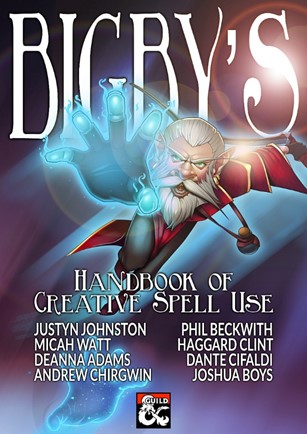 Bigby’s Handbook of Creative Spell Use is a 76-page supplement that describes techniques of using and combining spells to get more out of them than might initially be apparent.
Bigby’s Handbook of Creative Spell Use is a 76-page supplement that describes techniques of using and combining spells to get more out of them than might initially be apparent.
The supplement uses the landscape format, to the joy of some of my friends, and presents 50 spell-casting combinations.
They range from gloriously off-the-wall and brilliant, to mundane and obvious, and there are a few hopelessly complicated techniques that rely upon exactly the right situation to work – and a kind DM.
For instance, the idea of summoning pixies who then turn your party into tyrannosauruses to lay waste your foes is hilariously funny but runs into the problem of many DMs limiting who chooses which creatures turn up to a conjure woodland beings. (This is rightly noted by the text, which portions it off into one of three “problematic” techniques, that require a DM willing to go along with your plan).
I am bemused by the idea that using darkness and devil sight together makes the perfect time to use a healer’s kit – although with the Healer feat, this can restore a few hit points in a pinch.
However, the technique described as “The Flying Gnome” is inspired spellcasting at its best: you cast reduce on a gnome, which lowers their weight to around 5 points. You can then use mage hand to pick up and move the gnome. If you are an arcane trickster, you can do the entire combination yourself! It is quite mad and quite brilliant.
And then there’s “The Furnace” – first cast a force cage with bars, then use Wall of Fire to enclose it and cook whatever is inside!
The techniques include offensive, defensive, and utility combinations. It is an excellent selection, and though one might make you shake your head, the next might excite you!
As noted, the document is formatted in landscape – so it works well on the screen. It looks great, with good use of art and layout, although there are times when the text is a little too ornate or confusing. Consider these prerequisites for “The Furnace”:
An artificer (Artillerist), bard, cleric (Forge Domain, Light Domain), druid, sorcerer, warlock, or wizard with an available 4th level spell and 7th level spell slot (or the ability to cast the required spells), and the required spells prepared (or known in the case of a non-preparing caster).
I found the text mostly straightforward, if not always enjoyable to read, but the ideas were fascinating. Many of these tricks show a different way at looking at spells, and if it gets you thinking more about spellcasting, then it has succeeded in its goal.
Bigby’s Handbook of Creative Spell Use provides exciting ways at looking at spells, and though some are esoteric or have demanding prerequisites, there is much to admire here. Recommended!

Thank you for the honest and insightful review!